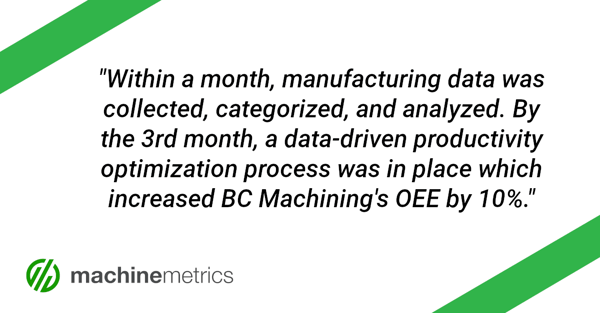Industry 4.0 is defined by smart manufacturing processes such as data-driven plant optimization, industrial automation, and predictive maintenance. Since these processes rely on shop floor data, configuring a smart or lights-out facility starts with setting up an effective data collection system.
This data collection system represents an investment for the manufacturer, in which they will expect a return. The assessment of the investment must include how quickly stakeholders can expect payback, what form the payback takes, and how tangible the returns are compared to the investment made.
Learn More: What Exactly is "Smart" Manufacturing? Using Technology to Drive Innovation
How is the Payback Period Measured for Smart Manufacturing?
As an accounting term, the payback period is defined as the amount of time required for cash inflows generated by a project to offset the initial investment made. In manufacturing, finding the payback on investments made involves more than tracking cash inflows.
Using a discrete manufacturing facility as an example, successfully cutting down previous operational costs through machine optimization or finally being able to receive insight into every stage of a production cycle are milestones to be celebrated. In this example, while reducing operational cost can easily be quantified financially, the actionable insight received from collecting shop floor data cannot, even though it affects every aspect of the production process.
With this in mind, here are the parameters that help with finding the payback from smart manufacturing investments:
Productivity Improvement – This refers to the impact of smart manufacturing in enhancing machine utilization and the performance levels of shop floor employees. Productivity improvements can be measured using overall equipment effectiveness calculations (OEE) and other benchmark standards. This makes it easy to calculate the payback for integrating smart manufacturing.
Quality Improvement – The quality of products manufactured serves as another parameter for measuring the payback for investments made. Defects per million opportunities (DPMO) calculations and other Six Sigma calculation models make tracking payback in terms of quality improvements possible.
Energy Optimization – In manufacturing, energy consumption generally accounts for approximately 18% of the total overhead cost for manufacturing a product. Thus, optimizing energy use is a way to define the payback on smart manufacturing investments.
Predictive Maintenance – Ensuring shop floor assets function optimally without experiencing unplanned breakdowns is one of the tenets of smart manufacturing. With predictive maintenance, manufacturers are able to predict equipment failures and reduce downtime, a major impact on their payback period and overall investment return.

How Quickly Should Manufacturers Expect Payback from Smart Manufacturing Initiatives?
Depending on the size and complexity of the industrial IoT investment, the payback period can be anywhere from a month to over a year.
Many manufacturers expect the integration of smart manufacturing models to yield results immediately. In some cases, manufacturers do receive payback with the first and third month after implementing a data collection system.
For example, BC Machining LLC, a contract manufacturer of metal parts, provides an excellent case study for this. In this case, MachineMetrics set up a data collection system for its CNC machines and connected them to the MachineMetrics IoT Platform.
Within a month, manufacturing data was collected, categorized, and analyzed. By the 3rd month, a data-driven productivity optimization process was in place which increased BC Machining’s OEE by 10%.
This example showcases how quickly payback from smart manufacturing can be achieved.
In other situations, such as quality improvement and predictive maintenance, research shows that payback should be expected within 6 to 12 months. This is because, to accurately analyze data related to these concepts, a longer duration of time is needed. The elongated duration ensures enough data is collected to determine machine performance and shop floor patterns over time. The data can then be used to develop maintenance schedules or quality control policies.
In these cases, MachineMetrics can speed up the payback process. Our IoT platform integrates benchmark data of both legacy equipment and new machines. This benchmark data includes machine runtime, load, optimal speed, and operational temperature. The data provides insight into your machines’ capabilities without having to wait for 12 months before developing an optimal quality control or predictive maintenance strategy.
The Short and Long Term Value of Smart Manufacturing
Smart manufacturing is expected to add approximately $1.5 trillion in value to the global economy by 2022. And the expected direct benefits to individual manufacturers include enhancing productivity, quality improvements, and optimizing machine use.
MachineMetrics localizes these benefits and brings them to your facility. It also ensures you receive the payback from your investments in record time through the plug-and-play services we offer. If you are looking to dramatically reduce the payback period for your smart manufacturing investments, please get in touch with our team.


.png?width=1960&height=1300&name=01_comp_Downtime-%26-Quality_laptop%20(1).png)


.gif)









Comments